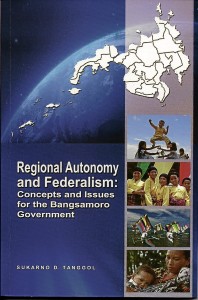
Sukarno D. Tanggol covers five major topics in this book: Regional Autonomy in the Philippines; Theory and Practice of Federalism; Federalism, Nationalism and Ethnic Conflict; Federalism in Switzerland; and Federalism in the Philippines: Status and Prospects.
The book may serve as an important resource for political science, governance and even contemporary Philippine history. Its discussions of the evolution and ideology of federalism are brief but substantial.
Option for governance
Tanggol starts his book with a short background of the conflict in Mindanao. The points he raises in this chapter are really nothing new since these issues have been raised and echoed elsewhere by Rudy Rodil, Samuel Tan, Jamail Kamlian and Nasser Maruhomsalic, among others. What is novel about Tanggol’s work is that he attempts to craft his account of history in such a way that the narrative paves the way for federalism as an option for governance.
A significant part of the historical background is the inclusion of the Memorandum of Agreement on the Ancestral Domain (MOA-AD), a major setback in the GRP-MILF peace process. I agree with Tanggol when traced the failure of the failed agreement to the wounds “borne of past animosities and conflicts.”
Tanggol has every right to lambaste some politicians who “ride on the emotions of the public to score points even without the benefit of objectivity and rationality.”
He continues by citing one of the causes of conflict in Mindanao, i.e. land. He writes that “some landed Christians fear the consequences of Moro self-governance to their properties. The issue of land is one of the causes of conflicts in Mindanao that sometimes invite the involvement of the MILF or AFP, thus clouding the real factors behind.”
In the next chapter, Tanggol tackles federalism. For him, if there are successfully federated states such as those in the Americas and Europe, there are failures as well like the former Soviet Union, United Arab Emirates and Indonesia. He’s partial toward Watt’s federal model.
Source of conflict
Tanggol considers issues of ethnicity and nationalism as conditions that may affect federalism. He points to marginalization as a major source of conflict and how federalism can serve as a tool for its resolution.
But Tanggol is not quick to propose federalism as the ultimate solution to the Bangsamoro issue. He shows how federalism worked for Switzerland, a country of diverse ethnicities and religion like the Philippines.
He underscores that even though the Philippines and Switzerland are “both faced with diversity… they have very diverse diversities” in many aspects. Despite this, the Swiss model may be emulated and adapted for the Philippines.
In the penultimate chapter, Tanggol lays down a clearly articulated proposal for federalism in the Philippines using Watt’s theories. What is worth noting is that while federalism has the potential for bringing closure to the Mindanao problem, Tanggol is quick to point out gaps that may cause its failures. For instance, he cites mutual distrust between the GRP and the Moros and the Christians. There’s also the existence of a small group that “always succeeds in stalling peace efforts for their vested interests.” There are also the perennial problems of poverty, violence, and graft and corruption of Mindanao leaders.
Overall, the book is a good read and deserves a space in the shelves of those who are interested in the Bangsamoro issue.